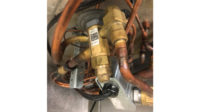A common metering device used on new walk-in cooler/freezers today is the electronic expansion valve (EEV). It allows for a tighter control of a refrigerant’s superheat value leaving the evaporator and a quicker reaction to changes in the evaporator’s heat load. However, as with all electronic components, there is a learning curve associated with troubleshooting some of its common failures.
These metering devices generally consist of several basic components: 1) a valve body with a needle valve assembly used to change its port opening; 2) a magnetic coil used to reposition the needle valve; 3) a suction pressure transducer; 4) a suction line temperature sensor; and 5) a control board to read a pressure transducer and a suction temperature sensor as inputs, then based on its programming, send a voltage signal to the magnetic coil to either move the needle valve into or away from the port.
When troubleshooting these valves, it is always best to obtain and follow the manufacturer’s service literature, as the design and operation may be slightly different from one manufacturer to another.
Generally, the first step in troubleshooting these valves is to measure actual suction pressure and suction line temperature of the refrigerant leaving the evaporator and calculate its current superheat value. Then, navigate to a menu on the control board to view these values, which should be similar. If the suction pressure or suction line temperature values are not similar, then likely the issue is with the sensor. Also check that the correct refrigerant type has been selected and the control superheat set point is correctly set on the board. If these values are wrong, it will also cause the valve to not operate correctly.
If the valve is still not operating properly, the next step is to measure the magnetic coil winding’s resistance. Following the manufacturer’s directions, measure the resistance of each winding and also verify that there is no continuity between the windings and ground. If the resistance values are not correct, then the likely issue is the coil, and it will need to be replaced.
If the resistance of the magnetic coil is okay, try to move the needle valve assembly with a magnetic tool obtained from the manufacturer. Turning the magnetic tool clockwise and counterclockwise will allow you to move the needle valve to a more open or more closed position. If using this tool does not cause a change in the suction pressure and/or temperature, then the valve needs to be replaced.
Another potential issue with these valves is their failure to completely close during the off-cycle or defrost cycle. These valves are often used to pump down the system when the case reaches its temperature set point or during a defrost cycle. These systems will not have a liquid line solenoid, because the EEV is designed to completely close during the off-cycle and defrost cycle, so it is not needed.
To test this function, either place the unit into a defrost cycle or raise the temperature set point and watch the system pump down. If it does not pump down properly, the EEV may need to be replaced. This issue could also be caused by a defective compressor. Before condemning the EEV, try pumping down the system using the king valve on the receiver. If you are able to pump the system down when the king valve is in its front seated position, then the EEV is the issue. If you cannot pump down the system with the king valve front seated, the compressor is the likely cause.
Troubleshooting these valves may seem a little complicated at first, but as you work with them more and more, the learning curve goes down and the ease of troubleshooting goes up.






Report Abusive Comment